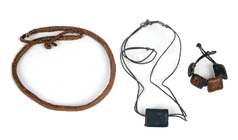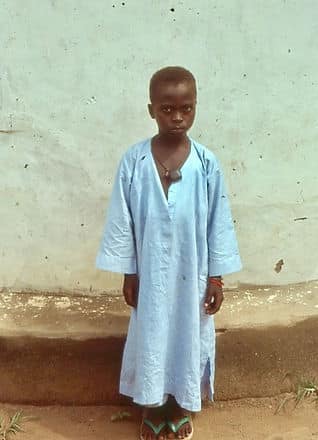Presented by Museum of the Peace Corps Experience and American University Museum
Belt, necklace, bracelet (left to right)
c. 1979
Lower River Division, The Gambia
Leather, written prayers, dimensions variable
Collection, Museum of the Peace Corps Experience
Gift of Paul Jurmo, The Gambia, Pakalinding 1976–79

If I go to The Gambia, my name is Kemo Sise. It was a common Peace Corps practice when I was a volunteer to adopt the name of a member of one’s host family. Sise was my host family’s name, one commonly found in Mandinka communities in The Gambia and Senegal. Kemo was the grandfather, the patriarch of my extended family.
He was a respected elder and religious leader. As such, he was one of the holy men who inscribed the prayers sewn into the amulets, or jujus, commonly worn in The Gambia in the 1970s. Jujus were leather pouches containing handwritten prayers. They might be worn on a string around one’s arm or neck—or a baby’s waist.
I think my landlord named me after Fa Kemo (Father Kemo) because they thought I was a learned man, as I was working on an adult literacy project. I took it as an honor to be named after the leader of my extended family and the village’s religious community. With that honor also came the responsibility of not doing anything to dishonor Fa Kemo’s name. In my memory and my heart, they remain one of my families. They are still a big part of me after 40 years.
I grew up as a Roman Catholic during a time when Catholics wore a scapular on a string around the neck. A scapular was basically a small plastic pouch containing a picture of the Blessed Virgin Mary or other holy figure and a little prayer. Every child in my Catholic school would be given a scapular and wear it, well, religiously. When I saw amulets worn in The Gambia, I realized that they were very similar to the scapulars of my Catholic youth. Such lightbulb experiences are one of the beauties of Peace Corps: discovering how similar different cultures are at their roots.

The Committee for a Museum of the Peace Corps Experience is a 501(c)(3) private nonprofit organization. Tax ID: EIN # 93-1289853
The Museum is not affiliated with the U.S. Peace Corps and not acting on behalf of the U.S. Peace Corps.
Museum of the Peace Corps Experience © 2024. All Rights Reserved.